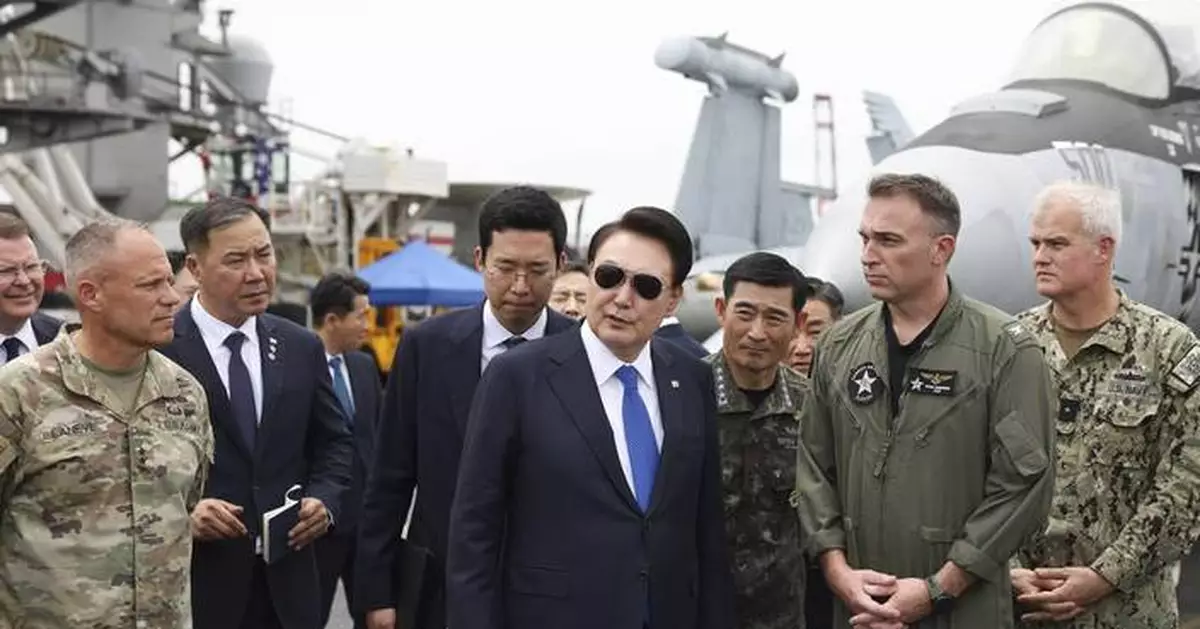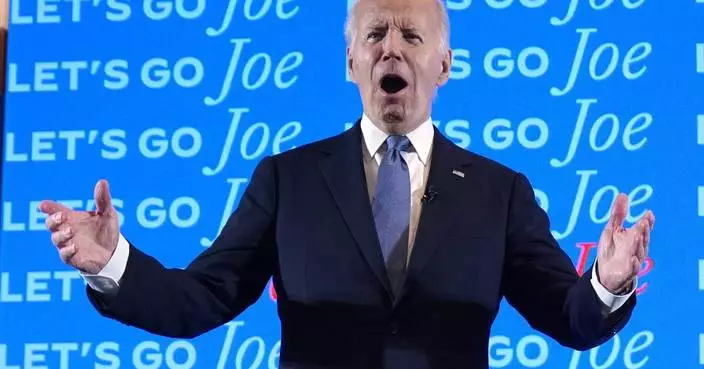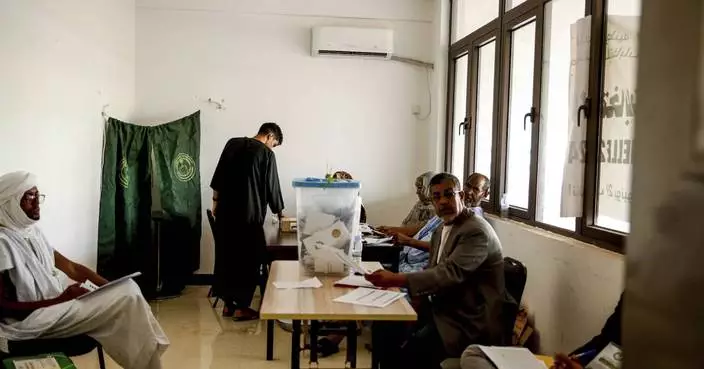GIMHAE AIR BASE, South Korea (AP) — The United States wrapped up its first multidomain exercise with Japan and South Korea in the East China Sea on Saturday, a step forward in Washington's efforts to strengthen and lock in its security partnerships with key Asian allies in the face of growing threats from North Korea and China.
The three-day Freedom Edge increased the sophistication of previous exercises with simultaneous air and naval drills geared toward improving joint ballistic-missile defense, anti-submarine warfare, surveillance and other skills and capabilities.
Click to Gallery
GIMHAE AIR BASE, South Korea (AP) — The United States wrapped up its first multidomain exercise with Japan and South Korea in the East China Sea on Saturday, a step forward in Washington's efforts to strengthen and lock in its security partnerships with key Asian allies in the face of growing threats from North Korea and China.
FILE - The Theodore Roosevelt (CVN 71), a nuclear-powered aircraft carrier is anchored in Busan, South Korea, on June 22, 2024. The newly-inaugurated Freedom Edge exercise is wrapping up in the East China Sea, having brought together Japanese, South Korean and American naval assets for multi-domain maneuvers for the first time.(Song Kyung-Seok/Pool Photo via AP, File)
In this photo provided by U.S. Navy, South Korean President Yoon Suk Yeol gives remarks aboard the Nimitz-class aircraft carrier USS Theodore Roosevelt (CVN 71) in Busan, South Korea, Tuesday, June 25, 2024. The newly-inaugurated Freedom Edge exercise is wrapping up in the East China Sea, having brought together Japanese, South Korean and American naval assets for multi-domain maneuvers for the first time. (Mass Communication Specialist Seaman Aaron Haro Gonzalez/U.S. Navy via AP)
In this photo provided by the U.S. Navy, a U.S. fighter jet takes off from USS Theodore Roosevelt aircraft carrier during the Freedom Edge exercise by the U.S., Japanese and South Korea at East Sea on Friday, June 28, 2024. (Mass Communication Specialist 2nd Class Rashan Jefferson/The U.S. Navy via AP)
In this photo provided by the U.S. Navy, a U.S. fighter jet prepares to take off from USS Theodore Roosevelt aircraft carrier during the Freedom Edge exercise by the U.S., Japanese and South Korea at East Sea on Friday, June 28, 2024. (Mass Communication Specialist 2nd Class Rashan Jefferson/The U.S. Navy via AP)
In this handout photo provided by the U.S. Navy, MH-60S Sea Hawk, assigned to the "Eightballers" of Helicopter Sea Combat Squadron (HSC) 8, lands on the flight deck of the Nimitz-class aircraft carrier USS Theodore Roosevelt (CVN 71) during exercise Freedom Edge, on Friday, June 28, 2024. The newly-inaugurated Freedom Edge exercise is wrapping up in the East China Sea, having brought together Japanese, South Korean and American naval assets for multi-domain maneuvers for the first time. (Mass Communication Specialist Seaman Aaron Haro Gonzalez/U.S. Navy via AP)
FILE - An F-18 fighter aircraft sits in the hanger of the Theodore Roosevelt (CVN 71), a nuclear-powered aircraft carrier, anchored in Busan Naval Base in Busan, South Korea Saturday, June 22, 2024. The newly-inaugurated Freedom Edge exercise is wrapping up in the East China Sea, having brought together Japanese, South Korean and American naval assets for multi-domain maneuvers for the first time.(Song Kyung-Seok/Pool Photo via AP, File)
FILE - South Korean President Yoon Suk Yeol, center, boards the USS Theodore Roosevelt aircraft carrier at the South Korean naval base in Busan, South Korea, Tuesday, June 25, 2024. The newly-inaugurated Freedom Edge exercise is wrapping up in the East China Sea, having brought together Japanese, South Korean and American naval assets for multi-domain maneuvers for the first time. (South Korean Presidential Office/Yonhap via AP, File)
The exercise, which is expected to expand in years to come, was also intended to improve the countries' abilities to share missile warnings — increasingly important as North Korea tests ever-more sophisticated systems.
Outside of Australia, Japan and South Korea are the only U.S. partners in the region with militaries sophisticated enough to integrate operations with the U.S. so that if, for example, South Korea were to detect a target, it could quickly relay details so Japanese or American counterparts could respond, said Ridzwan Rahmat, a Singapore-based analyst with the defense intelligence company Janes.
“That’s the kind of interoperability that is involved in a typical war scenario,” Rahmat said. “For trilateral exercises like this the intention is to develop the interoperability between the three armed forces so that they can fight better as a cohesive fighting force.”
Such exercises also carry the risk of increasing tensions, with China regularly denouncing drills in what it considers its sphere of influence, and North Korea already slamming the arrival of the USS Theodore Roosevelt carrier group in the port of Busan — home to South Korea’s navy headquarters and its Gimhae Air Base — in preparation for Freedom Edge as “provocative” and “dangerous."
On Wednesday, the day after South Korean President Yoon Suk Yeol visited the Roosevelt in Busan, becoming the first sitting South Korean president to board a U.S. aircraft carrier since 1994, North Korea tested what it said was a multiwarhead missile, the first known launch of the developmental weapon, if confirmed.
South Korea’s military said a joint analysis by South Korean and U.S. authorities assessed that the North Korean missile launch failed.
The defense cooperation involving both Japan and South Korea is also politically complex for both Yoon and Japanese Prime Minister Fumio Kishida, due to the lingering resentment over Imperial Japan’s brutal occupation of Korea before and during World War II.
The two countries have the largest militaries among American allies in East Asia — and together host some 80,000 American troops on their territories — but the U.S. has tended to work with them individually rather than together due to their history.
Kishida's increase of defense spending and cooperation with South Korea have generally been well received by the Japanese public but has caused friction with the right wing of his own party, while Yoon's domestic appeal has weakened, but he has stayed the course.
“South Korea’s shift under the Yoon administration toward improving its relations with Japan has been extremely significant,” said Heigo Sato, international politics professor and security expert at Takushoku University in Tokyo.
Both leaders are seen to be trying to fortify their defense relationships with Washington ahead of the inauguration of a new president, with South Korean officials saying recently that they hope to sign a formal security framework agreement with the U.S. and Japan this year that would lock in a joint approach to responding to a possible attack from North Korea.
U.S. President Joe Biden's administration has also long been working to increase cooperation between South Korea and Japan — something that many didn't think was possible at the start of his presidency, said Euan Graham, a defense analyst with the Australian Strategic Policy Institute.
“Credit where it’s due — the fact that it’s happening is a significant achievement from the administration’s regional policy,” he said.
Former U.S. President Donald Trump caused friction with both allies during his time in office by demanding greater payment for their hosting of U.S. troops while holding one-on-one meetings with North Korea’s Kim Jong Un.
Under Biden, Washington is seeking to solidify its system of alliances, both with increasingly sophisticated exercises and diplomatic agreements, Graham said.
“It’s obviously a U.S. attempt to try and mesh their alliances as positively as possible, not just given the challenge of their adversaries, but also the uncertainty around a second Trump administration,” he said. “They’re trying to institutionalize as many of these habits of cooperation while they can.”
Tensions with North Korea are at their highest point in years, with the pace of Kim Jong Un’s weapons programs intensifying, despite heavy international sanctions.
China, meantime, has been undertaking a massive military buildup of both nuclear and conventional weapons, and now has the world’s largest navy. It claims both the self-governing island of Taiwan and virtually the entirety of the South China Sea as its own territory, and has increasingly turned to its military to press those claims.
China and North Korea have also been among Russia’s closest allies in its war against Ukraine, while Russia and China are also both key allies for North Korea, as well as the military leaders of Myanmar who seized power in 2021 and are facing ever-stiffer resistance in that country’s civil war.
In Pyongyang this month, Russian President Vladimir Putin and Kim concluded a mutual defense pact, agreeing to come to the other's aid in the event of an attack, rattling others in the region.
Despite a greater number of ships overall, China still only has three aircraft carriers compared to the U.S. fleet’s 11 — probably the most effective tool a country has to bring vast amounts of power to bear at a great distance from home.
China’s advantage, however, is that its primary concern is the nearby waters of the Indo-Pacific, while Washington’s global focus means that its naval assets are spread widely. Following the exercises in the East China Sea with Japan and South Korea, the Roosevelt is due to sail to the Middle East to help protect ships against attacks by Yemen’s Houthi rebels.
That has made strong security partnerships all the more important, not only with Japan and South Korea but with Australia, the Philippines, Taiwan and others in the region, and building those up has been a priority for the Biden administration.
“One of the weaknesses of the Chinese navy, despite the number of hulls that they have compared to the Americans, is the fact that they don’t have a network of friendly ports from which they can operate in the event they need to launch a campaign,” Rahmat said.
“One of the strengths of the U.S. Navy is not just its ships and its technology, but its ability to call on a vast network of friendly ports and, aware of this strength, they are doubling down by increasing partnerships across the region.”
AP writer Mari Yamaguchi contributed to this story from Tokyo.
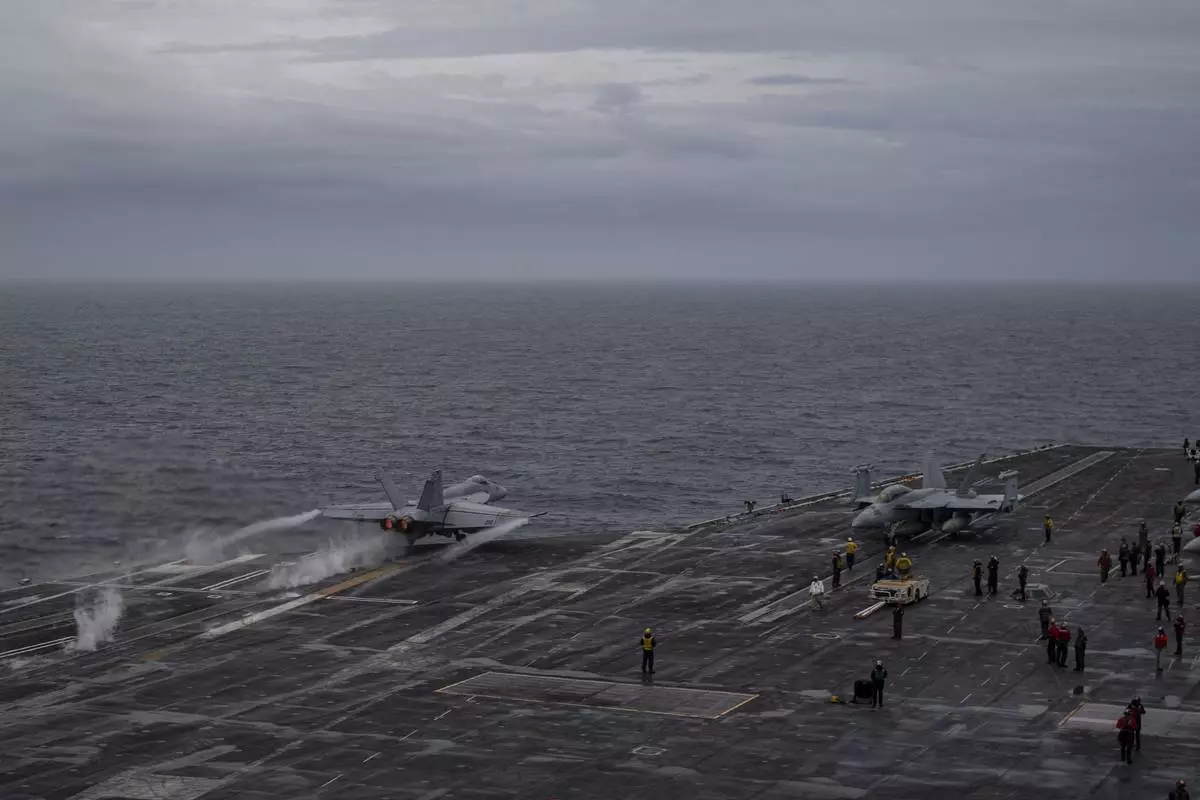
In this photo provided by the U.S. Navy, a U.S. fighter jet takes off from USS Theodore Roosevelt aircraft carrier during the Freedom Edge exercise by the U.S., Japanese and South Korea at East Sea on Friday, June 28, 2024. (Mass Communication Specialist 2nd Class Aaron Haro Gonzalez/The U.S. Navy via AP)
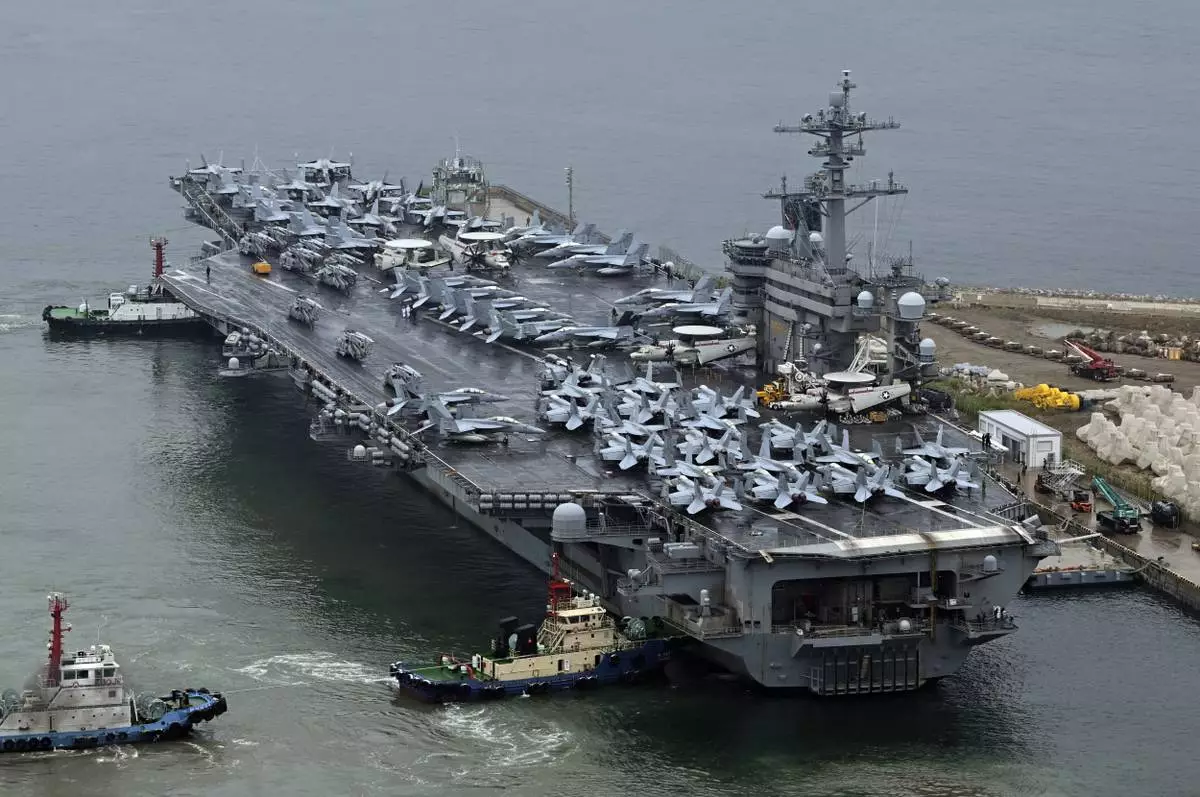
FILE - The Theodore Roosevelt (CVN 71), a nuclear-powered aircraft carrier is anchored in Busan, South Korea, on June 22, 2024. The newly-inaugurated Freedom Edge exercise is wrapping up in the East China Sea, having brought together Japanese, South Korean and American naval assets for multi-domain maneuvers for the first time.(Song Kyung-Seok/Pool Photo via AP, File)
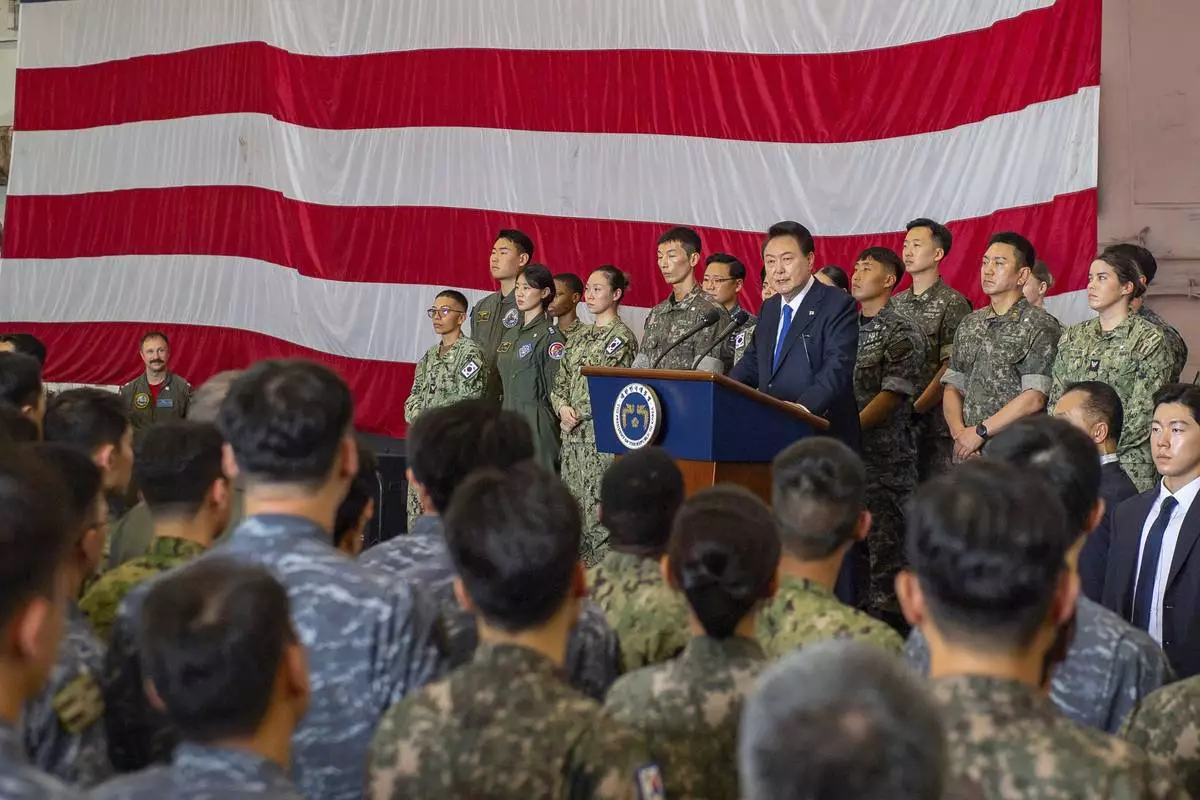
In this photo provided by U.S. Navy, South Korean President Yoon Suk Yeol gives remarks aboard the Nimitz-class aircraft carrier USS Theodore Roosevelt (CVN 71) in Busan, South Korea, Tuesday, June 25, 2024. The newly-inaugurated Freedom Edge exercise is wrapping up in the East China Sea, having brought together Japanese, South Korean and American naval assets for multi-domain maneuvers for the first time. (Mass Communication Specialist Seaman Aaron Haro Gonzalez/U.S. Navy via AP)
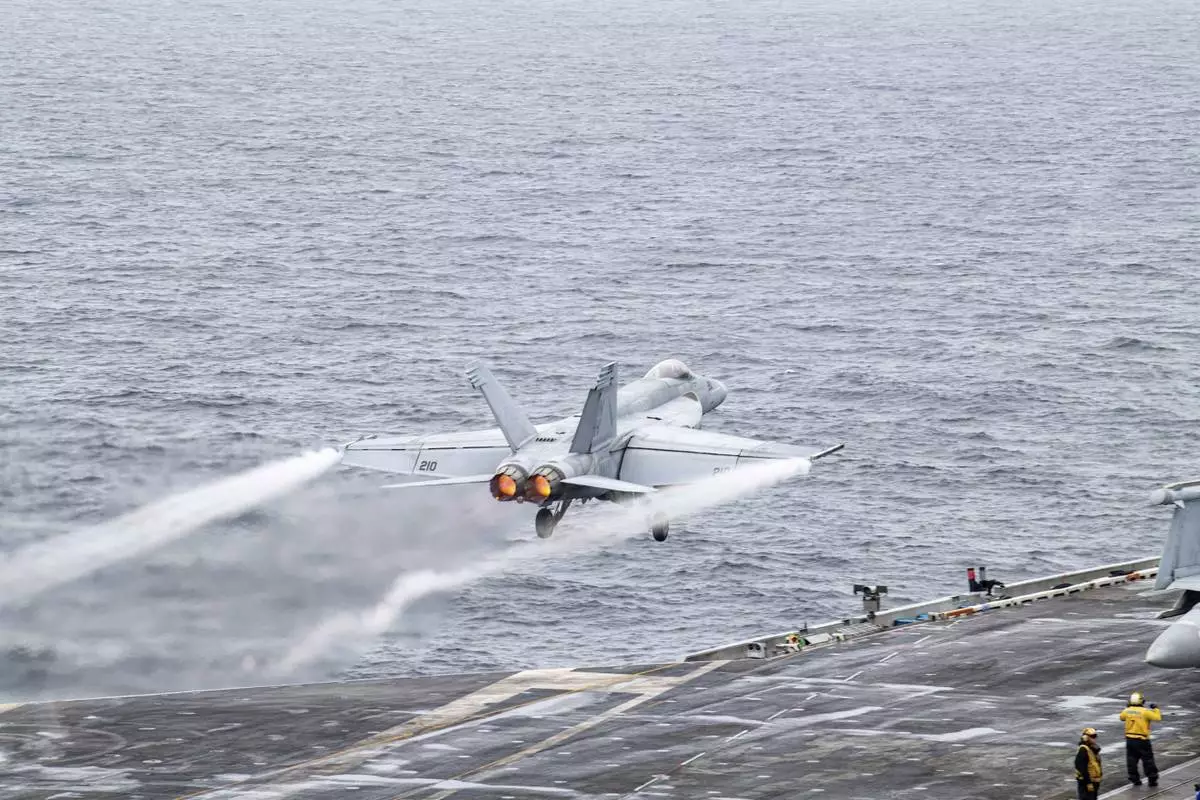
In this photo provided by the U.S. Navy, a U.S. fighter jet takes off from USS Theodore Roosevelt aircraft carrier during the Freedom Edge exercise by the U.S., Japanese and South Korea at East Sea on Friday, June 28, 2024. (Mass Communication Specialist 2nd Class Rashan Jefferson/The U.S. Navy via AP)
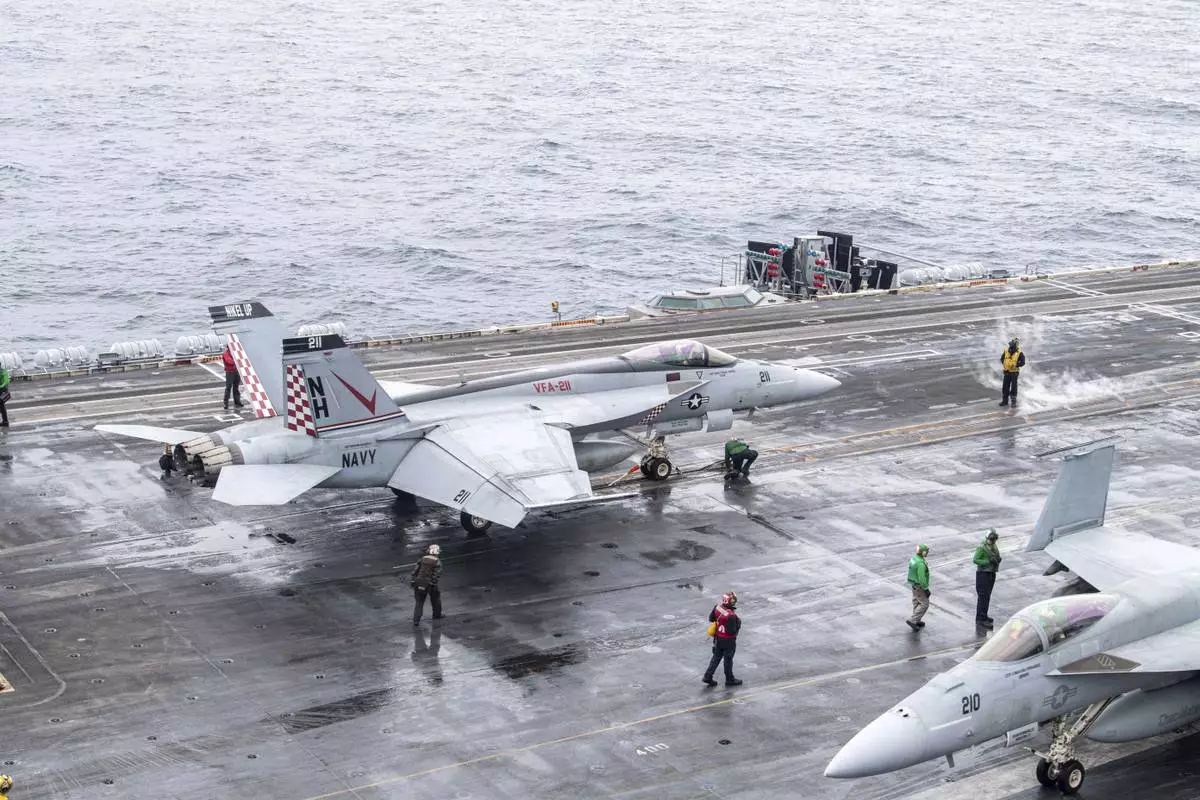
In this photo provided by the U.S. Navy, a U.S. fighter jet prepares to take off from USS Theodore Roosevelt aircraft carrier during the Freedom Edge exercise by the U.S., Japanese and South Korea at East Sea on Friday, June 28, 2024. (Mass Communication Specialist 2nd Class Rashan Jefferson/The U.S. Navy via AP)
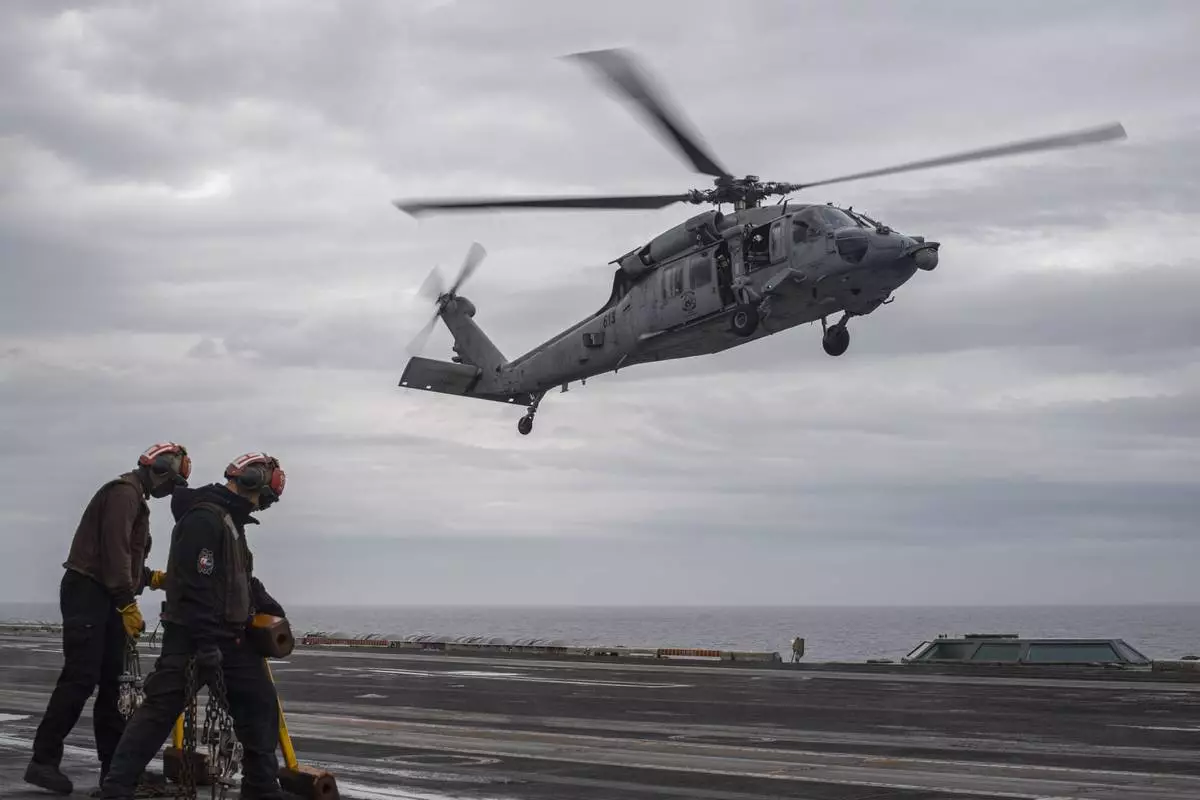
In this handout photo provided by the U.S. Navy, MH-60S Sea Hawk, assigned to the "Eightballers" of Helicopter Sea Combat Squadron (HSC) 8, lands on the flight deck of the Nimitz-class aircraft carrier USS Theodore Roosevelt (CVN 71) during exercise Freedom Edge, on Friday, June 28, 2024. The newly-inaugurated Freedom Edge exercise is wrapping up in the East China Sea, having brought together Japanese, South Korean and American naval assets for multi-domain maneuvers for the first time. (Mass Communication Specialist Seaman Aaron Haro Gonzalez/U.S. Navy via AP)
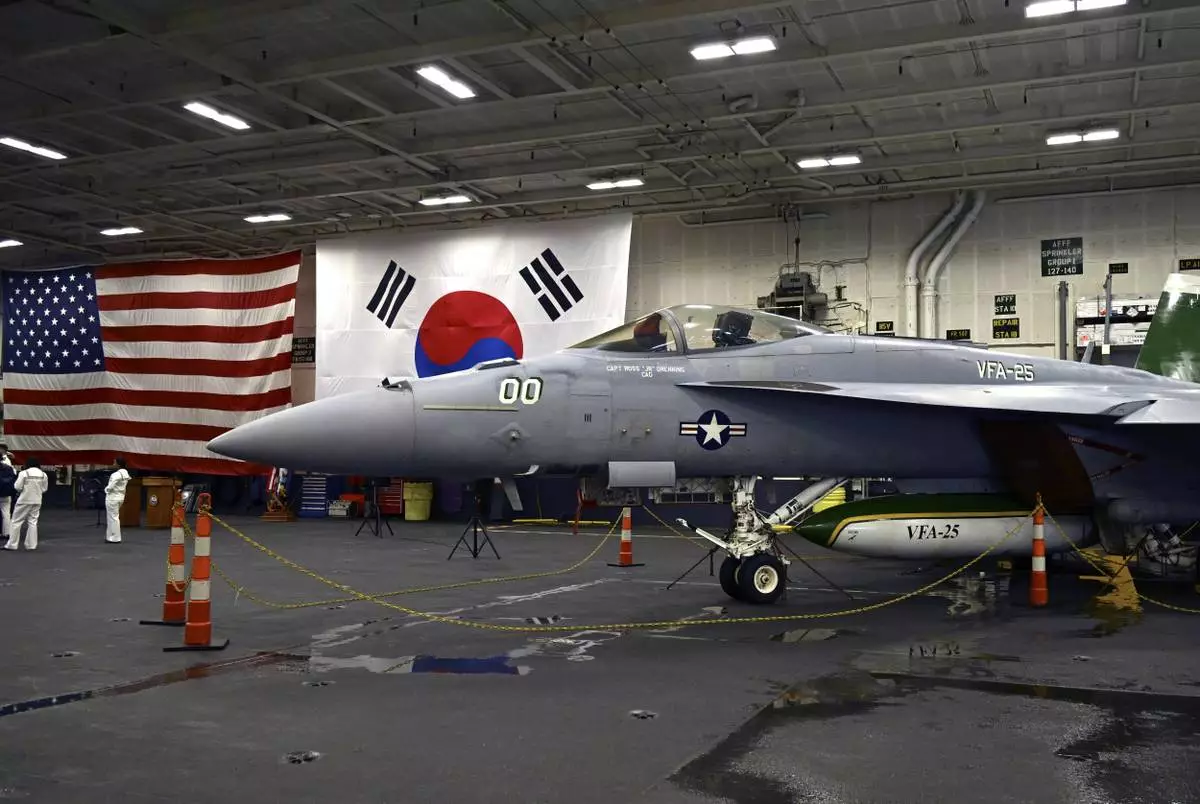
FILE - An F-18 fighter aircraft sits in the hanger of the Theodore Roosevelt (CVN 71), a nuclear-powered aircraft carrier, anchored in Busan Naval Base in Busan, South Korea Saturday, June 22, 2024. The newly-inaugurated Freedom Edge exercise is wrapping up in the East China Sea, having brought together Japanese, South Korean and American naval assets for multi-domain maneuvers for the first time.(Song Kyung-Seok/Pool Photo via AP, File)
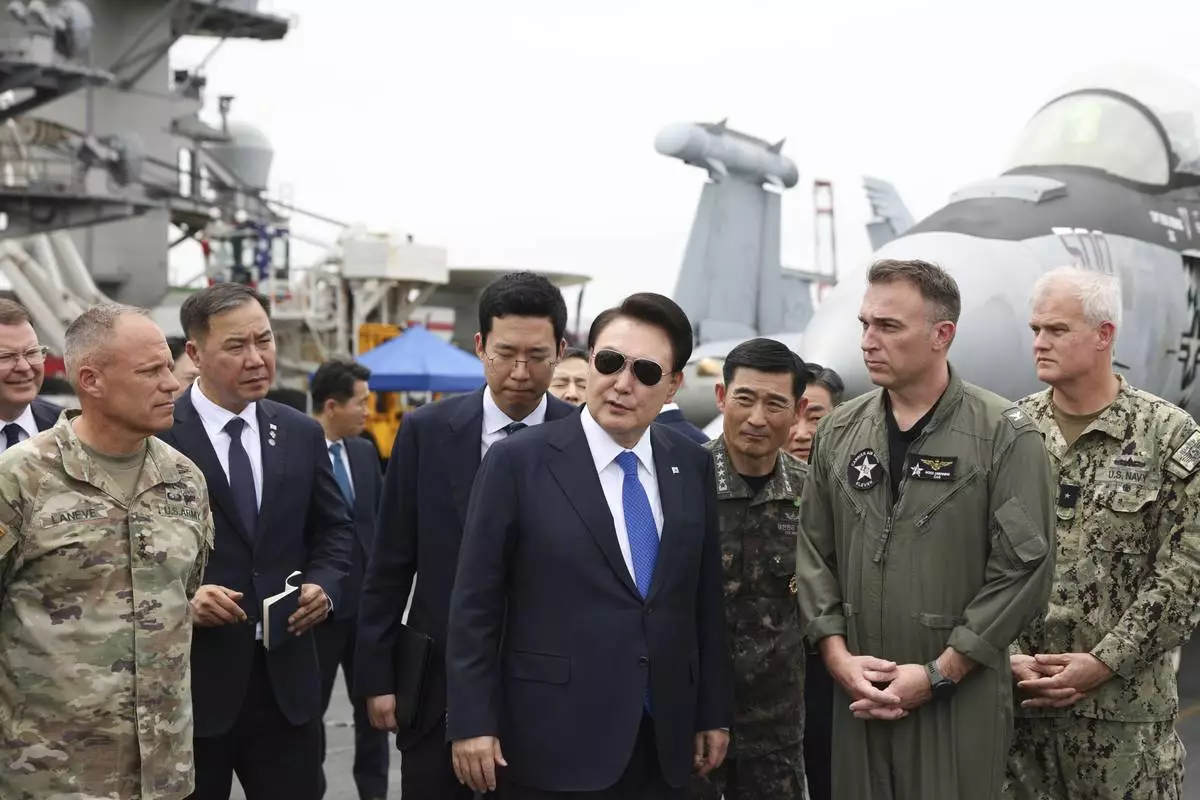
FILE - South Korean President Yoon Suk Yeol, center, boards the USS Theodore Roosevelt aircraft carrier at the South Korean naval base in Busan, South Korea, Tuesday, June 25, 2024. The newly-inaugurated Freedom Edge exercise is wrapping up in the East China Sea, having brought together Japanese, South Korean and American naval assets for multi-domain maneuvers for the first time. (South Korean Presidential Office/Yonhap via AP, File)
WASHINGTON (AP) — The Supreme Court's ruling Monday in former President Donald Trump's 2020 election interference case makes it all but certain that the Republican will not face trial in Washington ahead of the November election.
The Supreme Court did not dismiss — as Trump had wanted — the indictment alleging he illegally schemed to cling to power after he lost to President Joe Biden. But the ruling still amounts to a major victory for the presumptive Republican presidential nominee, whose legal strategy has focused on delaying the proceedings until after the election.
Trump posted in all capital letters on his social media network shortly after the decision was released: “BIG WIN FOR OUR CONSTITUTION AND DEMOCRACY. PROUD TO BE AN AMERICAN!”
The timing of the trial matters because if Trump defeats Biden, he could appoint an attorney general who would seek the dismissal of this case and the other federal prosecutions he faces. Or Trump could potentially order a pardon for himself.
Here's a look at the ruling and what comes next:
In a 6-3 ruling, the justices said that former presidents are shielded from prosecution for actions that fell within their official job duties, but they do not have immunity for unofficial acts.
The ruling means that special counsel Jack Smith cannot proceed with significant allegations in the indictment — or must at least defend their use in future proceedings before the trial judge.
The justices, for instance, wiped out Smith’s use of allegations that Trump tried to use the investigative power of the Justice Department to undo the election results even though officials told him they had uncovered no evidence of pervasive fraud.
The justices sent the case back to U.S. District Judge Tanya Chutkan, who must now “carefully analyze” whether other allegations involve official conduct for which the president would be immune from prosecution.
Among the issues for further analysis is Trump’s relentless badgering of then-Vice President Mike Pence to not certify the electoral votes on Jan. 6, 2021. The justices said it was “ultimately the Government’s burden to rebut the presumption of immunity” in Trump’s interactions with Pence, and sent the question back to Chutkan.
The order also directed additional analysis on the various posts on X, then known as Twitter, that Trump made — as well as a speech he delivered to supporters — in the run-up to the riot at the U.S. Capitol. Determining whether that communication represents official versus unofficial acts, the justices said, “may depend on the content and context of each" and thus needs more scrutiny.
The justices required fresh fact-finding on one of the more stunning allegations in the indictment — that Trump had participated in a scheme orchestrated by allies to enlist fake electors in battleground states won by Democrat Joe Biden who would falsely attest that Trump had won in those states.
The Trump team had argued that the selection of alternate electors was in keeping with Trump’s presidential interest in the integrity and administration of the federal elections and cited as precedent an episode he said took place in the disputed election in 1876.
The Smith team, by contrast, portrayed the fake elector scheme as a purely private action that implicated no presidential duty.
The conservative justices in their majority opinion didn’t answer the question as to which side was right, instead saying that “determining whose characterization may be correct, and with respect to which conduct, requires a close analysis of the indictment’s extensive and interrelated allegations.”
Unlike Trump’s interactions with the Justice Department, the justices said, “this alleged conduct cannot be neatly categorized as falling within a particular Presidential function. The necessary analysis is instead fact specific, requiring assessment of numerous alleged interactions with a wide variety of state officials and private persons.”
The three liberal justices — Sonia Sotomayor, Elena Kagan and Ketanji Brown Jackson — sharply criticized the majority’s opinion in scathing dissents. Sotomayor gave a dramatic speech as she read her dissent from the bench, at times shaking her head and gritting her teeth as she said the conservative majority wrongly insulated the U.S. president as “a king above the law.”
“Ironic isn’t it? The man in charge of enforcing laws can now just break them," Sotomayor said.
The dissenting justices said the majority decision maes presidents immune from prosecution for acts such as ordering Navy seals to assassinate a political rival, organizing a military coup to hold onto power or accepting a bribe in exchange for a pardon.
“Even if these nightmare scenarios never play out, and I pray they never do, the damage has been done. The relationship between the President and the people he serves has shifted irrevocably. In every use of official power, the President is now a king above the law,” Sotomayor wrote.
In a separate dissenting opinion, Jackson said the majority’s ruling “breaks new and dangerous ground.”
“Stated simply: The Court has now declared for the first time in history that the most powerful official in the United States can (under circumstances yet to be fully determined) become a law unto himself,” Jackson wrote.
The majority opinion accused the liberal justices of “fear mongering” and striking a “tone of chilling doom that is wholly disproportionate to what the court actually does today.”
The case will now go back to Chutkan, who would oversee the trial.
The trial was supposed to have begun in March, but the case has been on hold since December to allow Trump to pursue his appeal. Chutkan had indicated at that time she would likely give the two sides at least three months to get ready for trial once the case returns to her court.
That had left the door open to the case potentially going to trial before the election if the Supreme Court — like the lower courts — had ruled that Trump was not immune from prosecution.
But the Supreme Court's ruling that Chutkan must conduct further analysis is expected tie the case up for months with legal wrangling over whether the actions in the indictment were official or unofficial.
Trump was convicted in May of 34 felony counts in his hush money trial in New York and is scheduled to be sentenced on July 11. The falsifying business records charges are punishable by up to four years behind bars, but there's no guarantee Trump will get prison time. Other possibilities include fines or probation.
It seems almost certain that Trump's two other criminal cases will not go to trial before the election.
An appeals court recently halted Trump's Georgia 2020 election interference case while it reviews the lower court judge’s ruling allowing Fulton County District Attorney Fani Willis to remain on the case. No trial date had been set in that case.
Trump was supposed to stand trial starting in May in the other case brought by Smith, o ver classified documents found at Trump's Mar-a-Lago estate after he left the White House. But U.S. District Judge Aileen Cannon canceled the trial date as the case got bogged down with legal issues. She has yet to schedule a new one.
Last week, Cannon set the stage further delays by agreeing to revisit a ruling by another judge that permitted crucial evidence related to allegations of obstruction of justice by Trump to be introduced into the case.
One of the arguments Cannon has entertained — that Smith was illegally appointed and that the case should be dismissed — got little traction with the Supreme Court.
A separate concurrence from Justice Clarence Thomas concluded that Smith's appointment was improper, but no other justice signed onto that.
Associated Press reporters Michelle L. Price in New York and Stephen Groves in Washington contributed.

The Supreme Court in Washington, Sunday, June 30, 2024. (AP Photo/Susan Walsh)
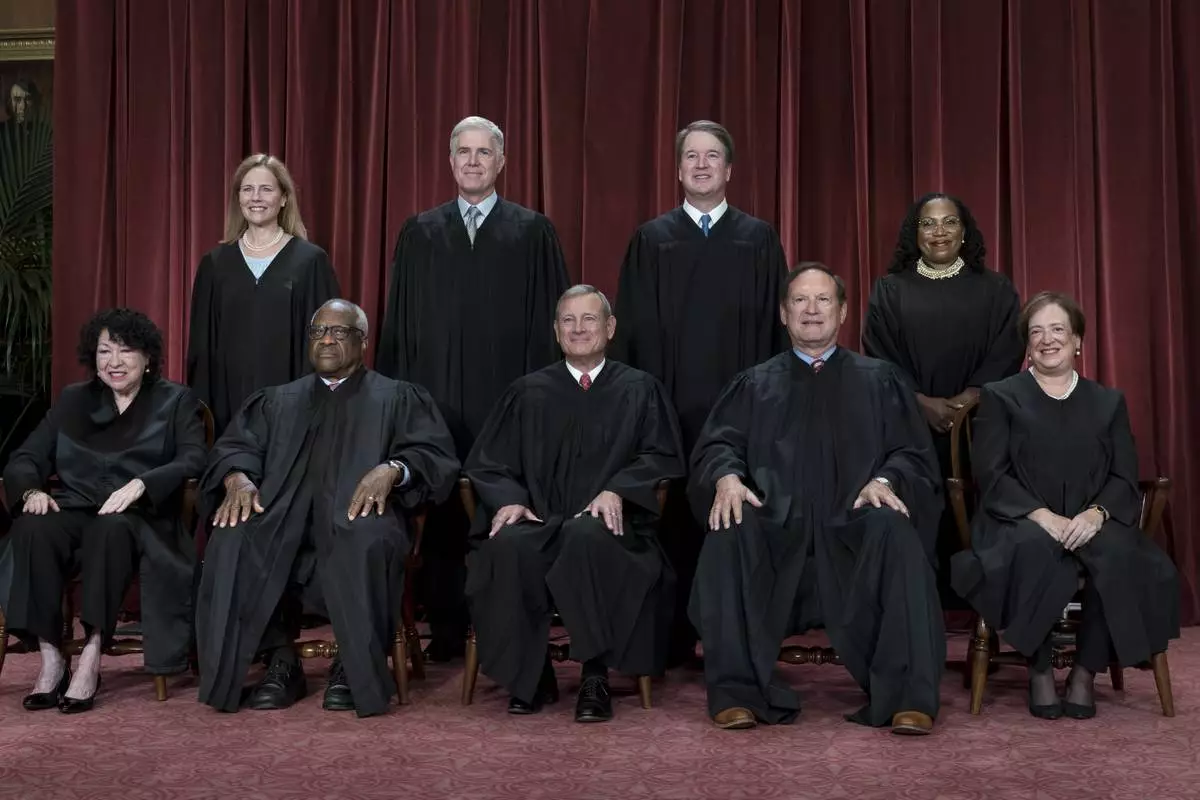
FILE - Members of the Supreme Court sit for a group portrait in Washington, Oct. 7, 2022. Bottom row, from left, Justice Sonia Sotomayor, Justice Clarence Thomas, Chief Justice John Roberts, Justice Samuel Alito and Justice Elena Kagan. Top row, from left, Justice Amy Coney Barrett, Justice Neil Gorsuch, Justice Brett Kavanaugh, and Justice Ketanji Brown Jackson. The Supreme Court justices will take the bench Monday, July 1, 2024, to release their last few opinions of the term, including their most closely watched case: whether former President Donald Trump has immunity from criminal prosecution. (AP Photo/J. Scott Applewhite)










